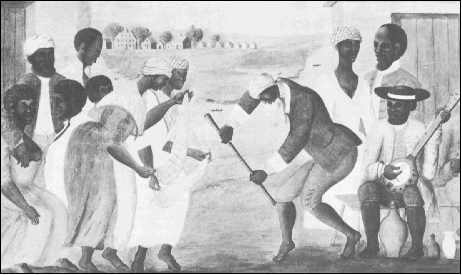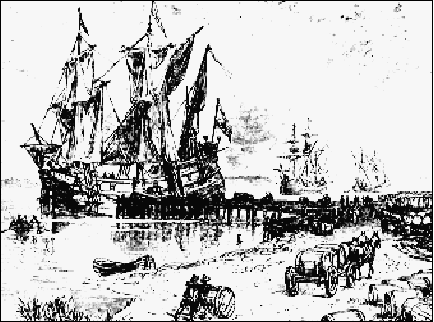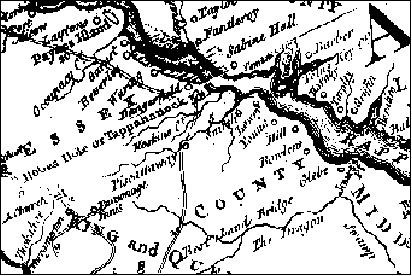|
|
|
Aaron Brughill |
| Aaron Brughill was ordered arrested for not appearing
"at ye suit of Samuel Clayton in Debt" in Essex County,
Virginia on May 18, 1720. This is the earliest record of the Broughill
name so far found in America. Who was Aaron Broughill and where did he
come from? One fact is certain: in 1720, he was living in Virginia. |
|
Aaron Brughill of England |
An Aaron Brughill was
christened on May 6, 1666 in Stalmine, Lancashire by his father James.
This is the only mention of the name Aaron in the English Parish
Records. They contain no record of his marriage, nor the christening of
his children. Compounding the information blackout, Stalmine Parish
lists no other Broughill, etc. marriage or christening. In fact, other
than the 1657 marriage of Elnor Brughell to Robert Baate in Warrington,
there are no other parish records entries for any Broughall, etc. in
Lancashire between 1637 and 1701. However the solitary entry does
provide two important bits of information: the year of Aaron's birth and
the name of his father.
English Parish Records
show that a James Broghall/Broughall christened John (1660), Margareta
(1667), James (1669 & 1670), Henry (1670), and Charles (1673), at
Newcastle Under Lyme in Stafford County, England. Other than Aaron's
christening, these are the only references to a James Broughill to
appear in English parish records during the entire seventeenth century.
Aaron's 1666 christening fits neatly between the first two christenings.
This suggests this James of Stalmine and James of Newcastle Under Lyme
were one and the same person. Apparently after the christening of John,
he moved to Stalmine, most likely for work. James returned to Stafford
County sometime between Arron's christening in 1666 and Margareta's
christening the following year. James probably descended from Radulphus
Broughall who christened sons in Newcastle Under Lyme in 1566 and 1569. |
|
Aaron's Immigration |
|
No immigrations records
were maintained during the Colonial period so the genealogist must
resort to other records, ones that imply immigration. The most
important of these is Virginia Land Patents and Grants. They resulted
from the Headright system whereby "adventurers" who paid their own
passage to Virginia received 50 acres of free land. Often a planter or
sea captain (the "headright") would pay a person's passage in
exchange for their agreeing to work as an indentured servant for a given
period of time. The patents name headrights and many (but not all)
indentured servants. They provide a fairly comprehensive account of 17th
century immigration, but contain little information on that of the next
century, because by 1700, the headright system had been largely replaced
by slavery. These records were abstracted and published by former
Virginia State Librarian Nell Marion in three volumes under the title, Cavaliers
and Pioneers. No Broughills appears in the index to these records,
which suggests that Aaron came to Virginia after 1700.
There are many thousands
of other documents which can also imply immigration, such as ship
passenger lists and English Court Records proving indentures and
"banishment to the Virginia Plantations." Although these are
scattered over hundreds of different locations, during the past decade
William Filby and Virginia Myers have been compiling a master index to
all names in all sources. Their monumental Index to Passenger and
Immigration Records presently consists of twelve volumes, each two
inches thick, listing names in telephone directory format - one line per
entry, three columns per page. Instead of a phone number, the year,
source and page number are given. Each volume contains over a million
names, but none contains any reference to the Broughall name during the
colonial period.
The location of a
person's home often provides a clue as to the approximate time they came
to Virginia. Virginia has four major rivers which flow in a northwest to
southeast direction. From north to south they are the Potomac, the
Rappahannock, the York and the James. The first permanent English
settlement in the New World was at Jamestown on the James River in 1607.
During the next few decades most immigrants settled along the shores of
this majestic river. As its land was consumed, settlement shifted
northward to the other rivers. Because of this, early 17th century
immigrants generally settled along the James and York Rivers, but later
arrivals settled along the Rappahannock and Potomac Rivers. Essex County
is on the south bank of the Rappahannock. The date and the location both
suggest that Aaron came to Virginia within a few years of the 1720 court
appearance. |
|
Coming to America |
During the first half of the
seventeenth century ships followed the "southern route" blazed by
Columbus. They followed the trade winds and currents which circulate
clockwise around the Atlantic Ocean. Ships leaving England sailed to
the Azores, then south to the Equator, then west to the Barbados.
After taking on water and supplies, they sailed toward what is now
Florida, where they picked up the Gulf Stream which helped propel them
to the Virginia Capes. After 1650, the shorter, more direct northern
route was used almost exclusively. It was essentially a straight line
across the Atlantic. The normal passage required seven to eight weeks
in good weather, but bad weather could prolong it considerably. The Bristol took
five months, the delay resulting from adverse winds off the Virginia
coast. On the other hand, in 1688 William Byrd I crossed from Land's End
to Cape Henry in only 28 days.
Shipboard conditions were
appalling. During the seventeenth century dozens and even hundreds of
passengers were crowded into small, dark, ill-ventilated cabins for
weeks at a time. They had to endure the discomfort of rough seas, poor
food and minimum sanitary facilities. Many ships were filthy and
rat-infested; disease was rampant and mortality frightful. Bradford in
his Plymouth Plantation told of a vessel bound for Virginia that
lost one hundred and thirty of its hundred and eighty passengers. An
early voyager to Virginia wrote home describing his experience on
shipboard: "betwixt decks," he said, "there can hardly a
man fetch his breath by reason there arisith such a funke in the night
that it cause putrification of blood and breedeth disease much like the
plague." By 1700 conditions had improved, but were still poor.
Virginia's colonial
economy was based on tobacco which was shipped from the colonies to
London; in fact, the city held a virtual monopoly on the crop throughout
the colonial period. During the first few decades of the seventeenth
century, most Virginia settlers sailed from London, but beginning about
1654, Bristol, located at the mouth of the Severn River in south west
England, became the premier supplier of new settlers.
Slavery was established
in Virginia in 1663, but depressed tobacco prices suppressed the trade
until they rebounded in 1680. Over the next 18 years, Virginia's slave
population rose from 2,000 to 6,000. Then, in 1698, the trade was fully
opened. The slave population quickly rose to 12,000 in 1708 and to
30,000 in 1730. James Slaughter, in his History of Essex
County, Virginia, wrote that the impact of slavery was substantial.
In 1699, Essex extended past present-day Fredericksburg; its population
was 2,602, of which 390 were black. By 1726, even though Essex's size
had been substantially reduced, its population had more than doubled to
7,416. Whites still formed a majority, but importation of slaves had
multiplied the county's black population several times. Slave ownership
as shown by estate inventories, jumped fifty percent between 1710 and
1719. In 1736, William Byrd II, appalled at the large number of slaves
being imported into Virginia, wrote that he feared the colony "will
come time or other be confirm'd by the Name of New Guinea." |
 |
|
Slaves in Colonial
Virginia |
|
Between 1699 and 1708,
39 vessels brought slaves to Virginia, 34 of them were of London
Registry and five were from Bristol. During the next decade, Liverpool
began its phenomenal rise in the slave trade, which was one of the
most spectacular commercial developments of the century. Of the 66
British vessels that imported Negroes into Virginia in 1710-18, 11
were from Liverpool. By 1751-63, Liverpool was furnishing 25 slavers
while the rest of England only provided 18. The significance of
this is that Aaron Broughill
was probably living in Stafford County, not far from Liverpool, so it is
doubtful that he would have traveled half-way across England to sail
from London or Bristol. Most likely, he sailed from Liverpool. If
so, then he may very well have sailed to America on one of the infamous
"slavers." |
|
Life in the Colony |
The
Englishmen who established their country's first permanent colonial
settlement in the New World at Jamestown in 1607 were confronted with
difficulties beyond their wildest imagination. They were precariously
perched on the edge of a great unknown continent, surrounded by thick,
seemingly impenetrable forests and often hostile Indians. They lived
in mud and wattle huts and had no depend-able source of food. Disease,
Indian Attack, Starvation, and hot, humid Summers were the four
horsemen of the Apocalypse that devastated their ranks. It is
estimated that over 6,000 brave men and women immigrated to Virginia
between 1607 and 1623, but the census of that year, showed less than a
quarter of them were still living.
During the next
century that all changed. By 1723, the Indians had all but been
annihilated. Lowland marshes around Jamestown had long been abandoned in
favor of higher, healthier ground and the colonists had become
acclimated to the hot, humid summers. They raised crops and livestock,
insuring a steady supply of food. Tobacco, which had been the colony's
staple crop since the 1620's, was king. Most of the colonists planted
what King James called the "vile weed," resulting in their
being called "planters." Over half of them owned their own
land, generally between 100 and 300 acres, which were known as their
"plantations."
Slavery drastically
changed their life style. During most of the 1600's, planters worked
their own fields, often with the help of one or two indentured servants.
By 1723, virtually every planter owned at least a couple of slaves, and
large planters owned several dozen. An indentured servant usually served
a term of four years, but a slave, even though he cost more, belonged to
the planter forever. The slave's children were a bonus. Tobacco
production increased and its sale brought wealth and permanence to
Virginia. During the winters, when there was little work to do in the
fields, slaves constructed frame and even brick homes for their masters.
The mud and wattle huts had long disappeared. Virginia's plantations
were developing the gracious lifestyles for which they would later
become famous.
Virginia colonists had
strong ties with England. Most were but a generation or two removed from
English birth. They did not establish any home industries, but relied on
the mother country for most of their manufactured goods - fabrics,
clothes, tools, books, furniture, house wares and the hundreds of other
things required for day to day living.
The great forests and
lack of usable roads made it difficult to travel overland, but Virginia
was blessed with dozens of rivers which flowed into the great Chesapeake
Bay. Life revolved around the bay and rivers, which were the highways of
the colony. Larger plantations had their own wharves but smaller ones
shared the use of community warehouses, where English ships would take
on hogsheads of tobacco and deliver needed goods. Many were manufactured
in England, but others came from around the world: sugar, molasses and
rum from the Caribbean; wines from France and Germany; and even silk
from the Orient. Many planters had an agent or "factor" in
England who would sell their tobacco and apply the sale proceeds toward
the purchase of such items. England also provided her colony with
culture: a body of law, representational government, and her church. |
 |
Life in Colonial Virginia revolved around
the sea. |
|
|
Southfarnham Parish |
By law, all Virginia
colonists were members of the Anglican Church and required to attend
its services. On Nov. 19, 1723, an Essex County Grand Jury presented
Aaron Broughel of
Southfarnham Parish for not frequenting his Parish Church. He failed to
answer the presentment and on Feb.18th, the Sheriff was ordered to take
him into custody. He failed to do so, and on March 19th, 1723 the
Sheriff was once again ordered to take him into custody. This time, he
was successful because Aaron appeared in court on April 21, 1724, (on
the old calendar, the year ended on the last day of March), only to have
the Grand Jury dismiss the charge.
There were two parishes
of the Anglican church in Essex County: St. Anne's was at the north end
of the county. To the south was South Farnham Parish; its Lower
Piscattaway Church stood near latter day Ozena at Marigold plantation.
By the early 1700s, it had replaced its old building with four new brick
churches. St. Farnham acquired a "new brick church" in 1728.
It was just east of Desha near the grounds of present day St. John's
Baptist in Tappahannock. Aaron had attended - or more properly not
attended - the Lower Piscattaway Church. Unfortunately, all colonial
parish records from North Farnham Parish have been lost. |
|
On the banks of the Piscattaway |
On
November 21, 1727, Ann Brohill signed an Essex County Deed between Henry Adcocke and John
Adcocke, both of the Parish of Southfarnham. (Interestingly she is not
identified in it as a witness) The 250 acre plantation was bounded
"on the river," and by several properties including those of
Lewis Latane and Leonard Hill. Lewis Latane purchased 300 acres from
John How on Nov. 12/13, 1725. It began at the main fork of Piscattaway
pocoson and ran up the main branch until it met the headline of James
Fullerton. Fullerton had received the land from his father who had
received a patent for it on Sept. 29, 1667, which describes it as 700
acres on the south side of the Rappahannock River upon the maine pocoson
of Puscattwa Creek. Leonard Hill had purchased his land from Reuben
Welch on Dec. 23/24, 1723. It is described as 150 acres near the head of
a small gut issuing out of Piscattaway Creek. The Samuel Clayton, who
brought suit against Aaron Broughill in 1720, had died by Aug. 19, 1735,
the date his will was proven in Essex County. In it, he devised his
plantation on the south side of Piscattaway Creek to his son George. On
July 16, 1717 Frances Adcocke together with Isaac Webb and Samuel
Clayton, their securities, acknowledge their bond for said Frances and
John's Executorship of the Last
Virginia was covered with thick underbrush and there
were few roads. People tended to stay very close to their homes.
The people named in the above deed all seem to have lived near another
and Aaron. This suggests he lived ont he Piscattaway River. |
| Essex County. The Piscattaway River is
near the center of the map. |
 |
|
| Disappearance |
The fifth and last reference to Aaron in Essex Court Orders appears on
Feb. 17, 1724, when he, along with Andrew Baker, John Gore, Jno. Borin, and Captain William Johnson
were ordered to attach the Estate of John Froman. Aaron then disappears
from the records, but may have still lived in Essex for a few more years
as Anne witnessed a will in 1727. Essex County Wills and Court Orders
are intact and give no clue as to his fate. If he had died in Essex,
then the county would have a copy of his will, or, if he died intestate,
the Court Orders would reflect the appointment of an Administrator and
an appraisal of his estate. The absence of such records proves that he
did not die in Essex County.
Spotsylvania County was
carved out of the northern part of Essex County in 1721, as was Caroline
County in 1728. Records for both counties have been checked and they
contain no reference to Aaron or Ann.
Aaron was never a land owner,
nor a planter. He was at least 54 years old when he first appears in
Essex's Court Orders in 1720. When he disappears from them four years
later, he was at least 59. At that age it is unlikely that he would have
wandered into the westward frontier. The most plausible explanation for
his disappearance is that he simply returned to England. If so, then it
raises a host of questions. Did he simply come to Virginia for a few
years for the work? He certainly would not have been a field hand as
were indentured servants of the seventeenth century, because such work
was then being performed almost exclusively by slaves. Did he work at
the tobacco warehouse on the Piscattaway River? Was he an agent for a
English merchant, or an overseer at one of the plantations? |
| |
| |
|